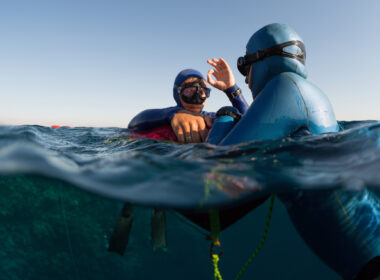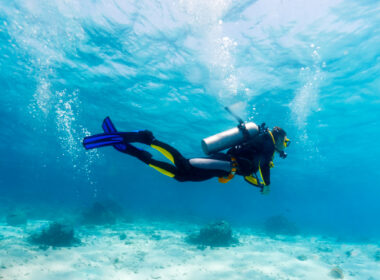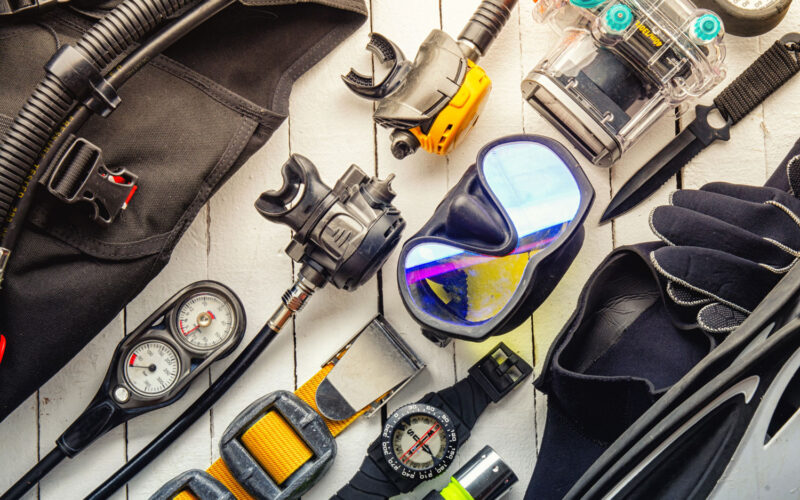It is all very well wanting your own dive equipment for safety, comfort, and hygiene reasons. But the benefits of owning equipment only last if you are willing and able to keep your dive equipment in good condition. Here we will discuss some tips on how to keep your dive gear in top shape. On top of what we can do, we also need to get our equipment serviced by a professional regularly, this can either be yearly, after a certain amount of dives
Keeping your dive gear in good condition is essential for both safety and longevity. Here are seven tips to help you maintain your dive gear and keep it looking good:
1. Rinse Thoroughly After Each Dive:
Saltwater can be corrosive to dive gear, so make sure to rinse all your equipment with fresh water after every dive. Pay particular attention to items like regulators, BCs, and dive computers, as salt can build up in crevices and cause damage over time. These items may benefit from the occasional soak in water.
You can use an old toothbrush to give your mouthpiece and inflator hose a good scrub, as well as to scrub around the mask lens where the silicone can collect a buildup of bacteria and algae.
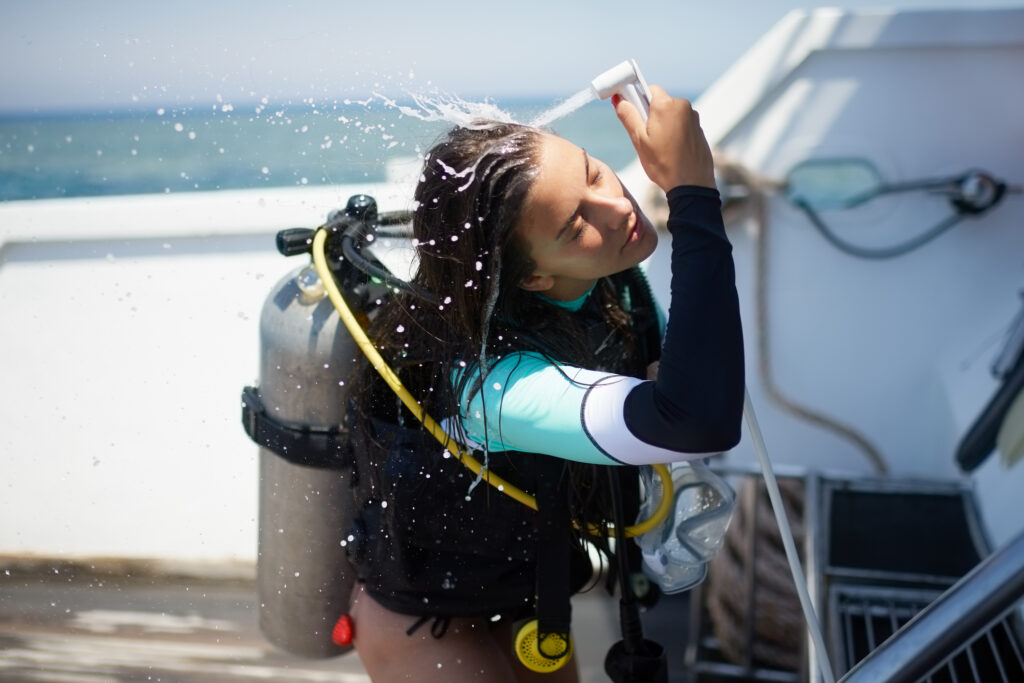
2. Dry Properly Before Storing:
After rinsing, allow your gear to dry thoroughly before storing it. Hang items like wetsuits, BCs, and regulators in a well-ventilated area out of direct sunlight. Don’t forget to inflate your BC and tip upside down, opening the deflate valve to see if there is any water stuck inside the BC bladder. Store the BC partially inflated, this ensures that the bladder doesn’t get stuck together. Check that everything is completely dry before storing to prevent mold and mildew growth, especially in wet areas like wetsuit boots and gloves.
3. Inspect Regularly:
Inspecting your dive gear regularly is crucial for ensuring it functions correctly and identifying any potential issues before they become problems. Check your gear regularly for signs of wear and tear. Look for any cracks, tears, or fraying in materials, and inspect metal components for rust or corrosion. Catching problems early can prevent more significant issues down the line.
Here’s what to look for when inspecting each item:
Regulator:
- Check hoses for any signs of cracks, bulges, or wear.
- Inspect the mouthpiece for any tears or deterioration.
- Test the regulator with the dust cap in place and ensure that when you try to breathe through the mouthpiece there are no air leaks, which could indicate potential water leaks underwater.
- Test the regulator’s function by breathing from it both in and out of the water. Ensure it delivers air smoothly and without any unusual sounds or resistance.
- Check the operation of the second stage, ensuring it purges and breathes smoothly.
- Verify that the pressure gauge starts at 0 and functions correctly when pressurized, check all other gauges for their functionality.
Buoyancy Compensator ( BC)
- Check all straps, buckles, and Velcro closures for signs of wear or damage.
- Fully inflate the BC and leave inflated for approximately one hour, check it again after the hour to see if it is still inflated.
- Check for leaks by listening for any hissing sounds or feeling of escaping air.
- Ensure the inflator mechanism and dump valves are working correctly.
- Inspect the bladder for any tears, holes, or punctures.
- Bend the inflator hose to look for any cracks or holes that might indicate that it has perished.
Mask:
- Check the mask skirt for any tears, cracks, or signs of deterioration.
- Inspect the lenses for scratches or other damage that may affect visibility.
- Ensure the mask strap is in good condition and securely attached to the mask frame.
- Test the mask’s fit and seal by pressing it gently against your face without the strap and inhaling through your nose. The mask should stay in place without leaking air.
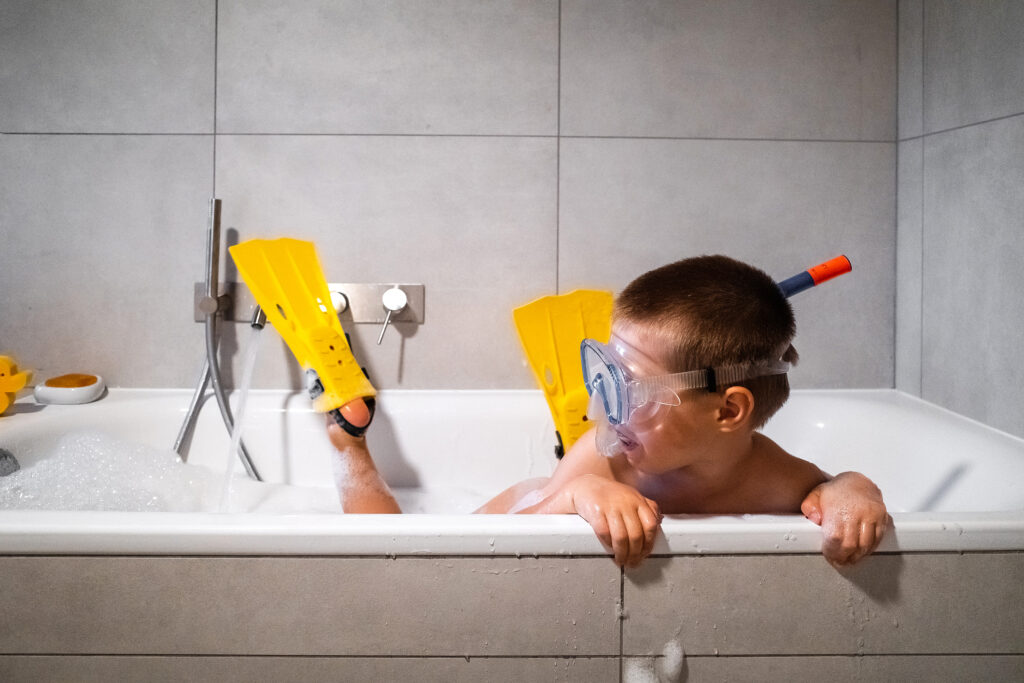
Weight Belt:
- Inspect the belt for any signs of fraying, cuts, or wear.
- Check the buckle for proper function, ensuring it opens and closes smoothly.
- Verify that the weights are securely attached to the belt and evenly distributed.
Wetsuit:
- Check for any tears, holes, or punctures in the neoprene material.
- Inspect seams for signs of separation or fraying.
- Ensure zippers are in good condition and zip smoothly without catching.
- Look for any signs of deterioration in the neoprene, such as stiffness or loss of elasticity.
Dry Suit:
- Check all seals, including wrist and neck seals, for any signs of damage or wear.
- Inspect the zipper for any corrosion, damage, or signs of misalignment.
- Ensure the valves for inflation and deflation are working correctly.
- Test the dry suit for leaks by conducting a thorough leak check, either with a commercial leak tester or by using soapy water to identify bubbles.
Regularly inspecting your dive gear and addressing any issues promptly can help ensure it remains safe and reliable for your underwater adventures. If you’re ever unsure about the condition of your equipment, it’s always best to consult with a qualified dive professional or technician.
4. Store Properly:
When not in use, store your dive gear in a cool, dry place away from direct sunlight. Avoid storing it in areas where it can be crushed or damaged. Hang wetsuits on wide hangers to maintain their shape, and store sensitive equipment like regulators in padded bags or cases. Especially if you don’t use your equipment regularly, get it out of storage and inspect it every couple of months to ensure it is ok. Get it out of storage and inspect it a good month before your next diving trip, allowing enough time to get it sent to a professional technician if needed.
5. Use Protective Cases:
Invest in protective cases for delicate equipment like dive computers, cameras, and lights. These cases can help prevent scratches, dents, and other damage during transport and storage. Remove batteries from cameras and torches before storing and store these separately, this way, if the battery becomes corroded and leaks it does not affect your expensive equipment.
6. Clean Regularly:
Periodically clean your gear to remove dirt, salt, and other debris that can accumulate over time. Use mild soap and water for most items, avoiding harsh chemicals that can degrade materials. Follow manufacturer guidelines for cleaning specific pieces of equipment, such as regulators and masks.
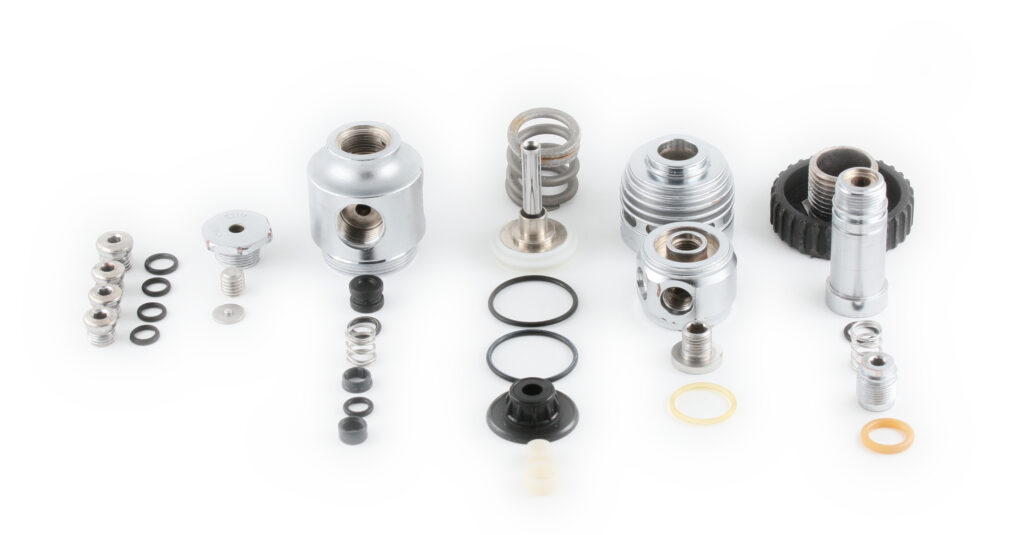
7. Service Equipment Annually:
Get your dive gear serviced annually or after every 100 dives by a qualified technician. This is especially important for life-support equipment like regulators and BCDs, as proper maintenance ensures they function correctly and safely. Keeping up with regular servicing can also extend the lifespan of your gear.
After an equipment service, it is highly recommended to do a test dive with it in a pool or confined water to ensure that all hoses have been tightened sufficiently and that everything is working properly.
By following these tips, you can help keep your dive gear in excellent condition, ensuring it stays safe, and functional, and looks good for years to come. It also avoids that you have to miss a dive or end a dive early due to malfunctioning equipment.


